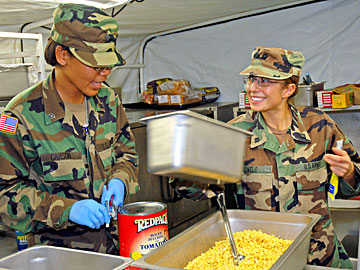IN THE MILITARY

GREGG K. KAKESAKO / GKAKESAKO@STARBULLETIN.COM
Spc. April Carson, left, and Spc. Leticia Melo prepared a noonday meal at Schofield Barracks' East Range 10 during an Army culinary competition last week.
|
|
Army chow then and now
Hawaii-based cooks test their skills against counterparts from the mainland and Europe
WHEN Sgt. Maj. Raymond Arnold enlisted in the Army 27 years ago as a cook, he learned to whip up meals for his troops from scratch, sometimes cooking in tents out in the field.
"It forced you to be creative," said Arnold, who is now the top enlisted soldier of the 25th Infantry Division's food service branch.
Over the past three decades, Army chow and the way it is delivered to soldiers in field has changed remarkably, Arnold noted as he watched members of the Headquarters and Headquarters Company of the 45th Special Troops Battalion prepare a noon meal at Schofield Barracks' East Range 10. The battalion is part of the newly reconstituted 45th Sustainment Brigade under the Army's transformation process.
"Back then, we had to prepare everything in what was called M1948 tent," Arnold said. "It was called 1948 because that is probably when the system began. The tents were difficult to set up, difficult to take down. They weren't very mobile."
Since 2002, the 25th Infantry Division has four containerized kitchens, each equipped with air conditioning, two refrigerators, eight gas burners and one oven. By February, the division will have 16. The Hawaii Army National Guard has an identical mobile facility.
Each kitchen can serve about 800 soldiers and comes equipped with a 10-kilowatt generator powered by JP-8 diesel fuel with electrical outlets and running water, said Sgt. 1st Class Stephan Dolic, food operations supervisor for headquarters company.
The containerized kitchens are mounted on a trailer that, when expanded, is 15 feet long and 10 feet wide. "It is mobile that it can even be air-dropped by parachute," Arnold said.
Arnold said the 25th Division also is equipped with smaller mobile kitchen trailers that serve about 300 soldiers.
Last week, Headquarters Company cooks faced three Army judges from the Army's quartermaster school in Virginia as part of the evaluation in the Philip A. Connelly Awards competition.
Their task during one stage of the testing was to prepare a noon lunch in its field kitchen facility called the "Paradise Cafe." The entrees were grilled pork chops and chicken parmesan with baked ziti, macaroni and cheese, zucchini and tomatoes, and seasoned green beans and corn. The dessert choices were Italian lemon cake or vanilla pudding.
Sgt. Major Tom Munson, the top enlisted soldier in the Army Center of Excellence, Subsistence organization at Virginia's Fort Lee, said the unit had already beat all competitors in the Pacific region and were now competing against units on the mainland and Europe.
Munson said the soldiers will be evaluated on how their operations area was set up, secured and administered, and on how food was prepared for soldiers in the field.
He said there are five categories: large garrison dining facility, where the cooks have to feed more than 400 soldiers; small garrison dining facility; active Army field kitchen; Army Reserve field kitchen; and Army National Guard field kitchen.
The cooks are seeking to win the active Army field kitchen category and the winners will be announced just before Christmas, Munson said, with the awards ceremony planned for April in Miami.
Last year, 25th Division cooks won the small and large garrison dining facilities categories.
Spc. April Carson, 27, said she has always loved to cook even before enlisting in the Army six months ago.
"I worked at several fast food operations in Alabama ... and I just loved to eat," said Carson, who will have her first combat deployment to Iraq in July.
Besides learning how to feed troops in the field, Carson said her unit has been working on unit security and other tasks necessary to survive in a combat environment.
Dolic, 38, was with the 25th Division when two of its units were sent to Iraq and Afghanistan last year.
"I always seem to be between deployments, but I am ready to go this time," said Dolic, 38.
Arnold said the containerized kitchens allow Army cooks to do everything in the field that they are able to do at a normal post dining facility, except broiling.
"Boil, deep fat frying, grilling and baking, we can do all that," Arnold said.
"Our burners can get as hot as 35,00 BTUs and run on JP-8 diesel fuel."

